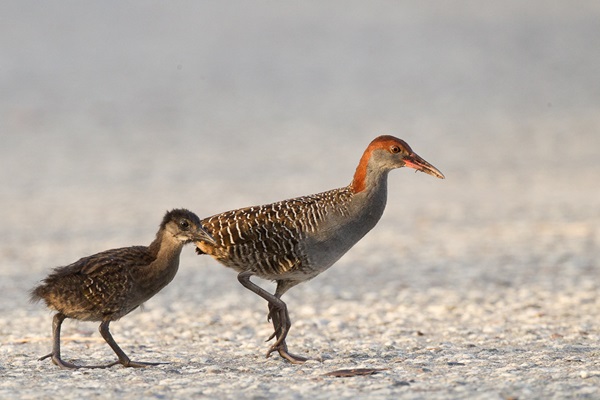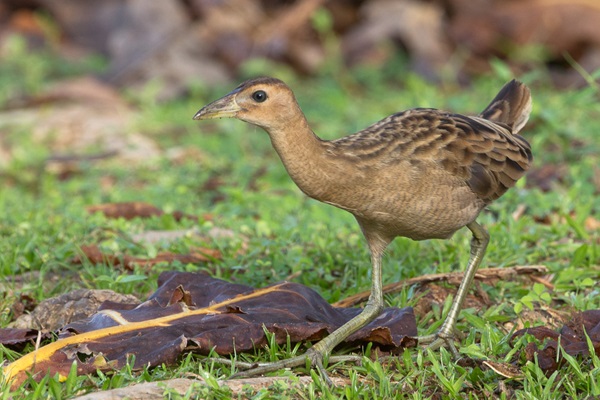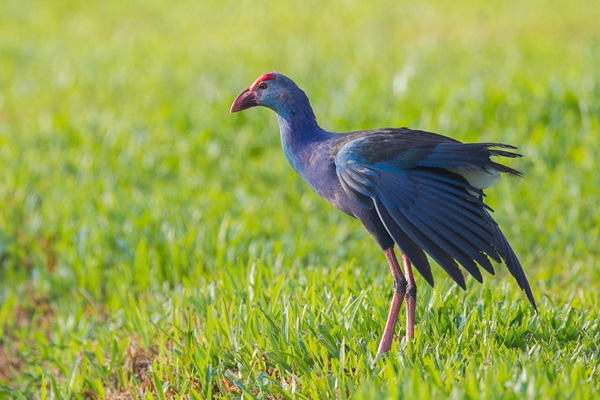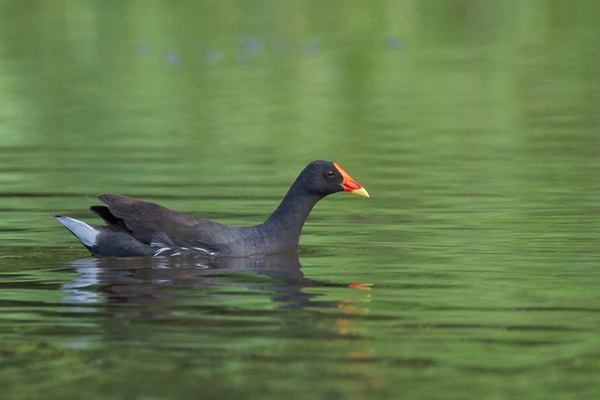Shy and Elusive Birds
Crakes and rails are terrestrial swamp-dwelling wading birds that live near water bodies and in forested areas of Singapore. These omnivores have strong long legs that enable them to walk and run vigorously on uneven surfaces. Most species are also capable of swimming.
Generally, crakes and rails are shy, secretive and skulk around but they move quickly for cover at the slightest sign of danger. This means they are often hard to spot here in Singapore.
Their calls are unique; loud and distinct and while they do not appear to have a powerful flight due to their short wings, some species do undertake annual migrations and are known to travel long distances.
Learn more about them and keep your eyes peeled the next time you are out near water bodies, to try to identify them.
Slaty-breasted Rail

The Slaty-breasted Rail (Gallirallus striatus) has a long reddish bill, a chestnut crown and nape and a slaty grey breast. It has fine white barring on its upperparts and its throat is pale grey.
Measuring about 30 cm, this bird makes a sharp and distinct “cirrk” sound as well as short jerking screams when alarmed. It is a solitary bird and can be found in freshwater swamps, reed beds, banks of small streams, drains and ditches.
White-breasted Waterhen

The White-breasted Waterhen (Amaurornis phoenicurus) has a white face, a yellow bill with a red base, and greenish legs. Its upperparts are in a dark slaty grey colour, which contrasts with its white underparts.
It can measure up to 33 cm and makes a harsh disyllabic “krruwak, krruwak” call. It also grunts, chuckles and croaks! This species is the most frequently seen rail in Singapore and resides in inland freshwater swamps, swampy vegetation, reed beds, and banks of forested streams. It can also be found in our urban parks and gardens, near ponds and grassy areas.
Unlike the Slaty-breasted Rail, this species can sometimes be seen in small loose groups, clambering onto small bushes and trees. However, the White-breasted Waterhen is shy and wary, so watch it from afar if you do spot one as it is quick to scurry for cover at the slightest hint of danger.
Watercock

The Watercock (Gallicrex cinerea) measures about 43 cm and is quite large in size compared to the other birds listed here. Interestingly, the physical appearance of the Watercock is different for the breeding male, female and non-breeding male.
For the breeding male, its plumage is blackish grey mottled with buff brown on the upperparts. Its bill, frontal shield and legs are red. For the female and non-breeding male, its flanks are buff brown with dark streaks and its legs are yellowish green. The non-breeding male lacks a frontal shield.
Regardless of its gender, the Watercock is well-known for its series of deep booming notes, “gok-gok-gok-gok…”, uttered rapidly. It is usually seen solitary in inland freshwater swamps, wet grasslands, canals, marshes and reed beds.
Black-backed Swamphen

Contrary to its name, the Black-backed Swamphen (Porphyrio indicus) actually has deep bluish-purple plumage with a red bill and forehead. It also has red legs and feet with long toes.
Measuring around 50 cm, this species makes short nasal grunts and croaking sounds. They are usually seen in small groups and reside in marshy, vegetated freshwater bodies such as swamps, rivers, and lakes.
Common Moorhen

The Common Moorhen (Gallinula chloropus) has a bright red bill with a yellow tip, a blackish plumage with a white line along its flanks, and green legs. Its upperparts are tinged with brown and its underparts are tinged with grey.
This species measures about 33 cm and makes a loud and abrupt “prruk” sound. They are usually seen in small loose groups dabbling largely on water surface vegetation. It dives well and sometimes feeds on land near the water’s edge. When it gets alarmed, it can patter along the water surface in a short, sustained flight.
Visiting our Green Spaces
In addition to looking out for these crakes and rails, during migratory season, which happens from Septemer to March, migratory birds make their way to our parks and nature reserves, particularly Sungei Buloh Wetland Reserve.
Help protect our natural heritage by being a responsible visitor when visiting our nature parks and nature reserves. Here are some other simple do’s and don’ts when visiting.
To ensure the well-being of our biodiversity, visitors to our nature parks and reserves should adhere strictly to the opening hours of 7 am to 7 pm. Disturbances to the nocturnal animals’ activities could mean disruptions to their natural behaviour, including venturing outside the nature parks and reserves. This will endanger both their own safety and that of the general public.
If you are heading to our green spaces, do the right thing and be socially responsible. Maintain a safe distance from other park goers and keep to not more than five persons in a group. Always wear a mask except when you are engaged in strenuous exercise or when consuming food, drink or medication.
Do check out the visitorship levels of our parks using our safe distancing portal before you head down and avoid the ones with high visitorship.
Learning More
Love to bird-watch, or want to learn more on identifying garden birds? Join us for Garden Bird Watch, that runs twice a year as part of the NParks Community in Nature Biodiversity Watch series. Click here for more information.
Interested to learn about the flora and fauna found in Singapore? Visit NParks Flora & Fauna Web here.
If you like what you read, follow us on Facebook, Instagram and Telegram to get the latest updates.
Text by Charlyn Ng
Photos by Francis Yap
About the writer
Charlyn Ng is an undergrad at the Wee Kim Wee School of Communication and Information. She is currently in her third year and specialises in Media Research and Analytics. Ever since starting her internship with NParks, Charlyn has been heavily involved in collecting and analysing data from various NParks’ social media platforms. Her efforts are focused on increasing the public awareness towards Singapore’s biodiversity. She also conceptualised and organised photoshoots and wrote articles about NParks conservation initiatives.
Please email wong_yeang_cherng@nparks.gov.sg for more information on our internship programme.


Have views or comments on this article? Let us know via this form. If you would like to give us feedback on any other areas relating to our parks and gardens, please submit via https://www.nparks.gov.sg/feedback